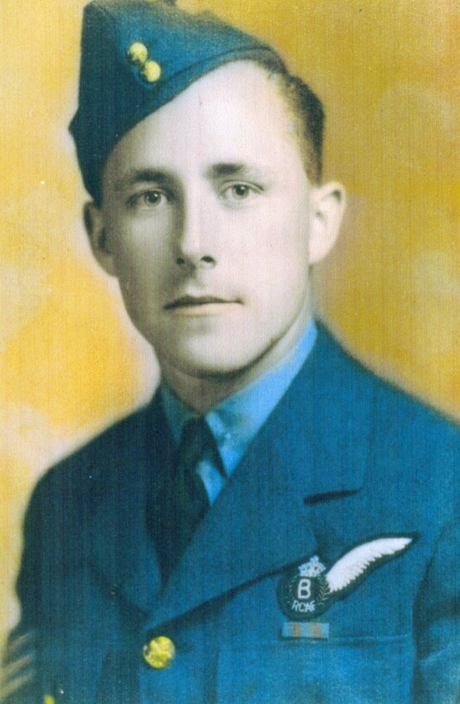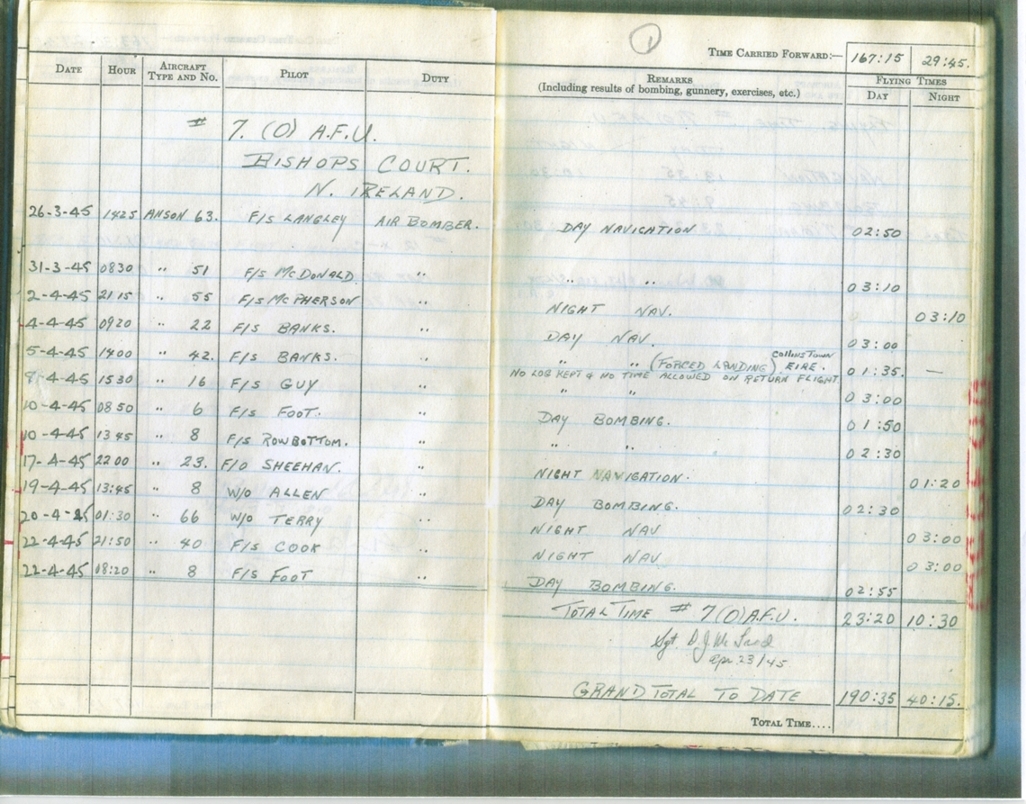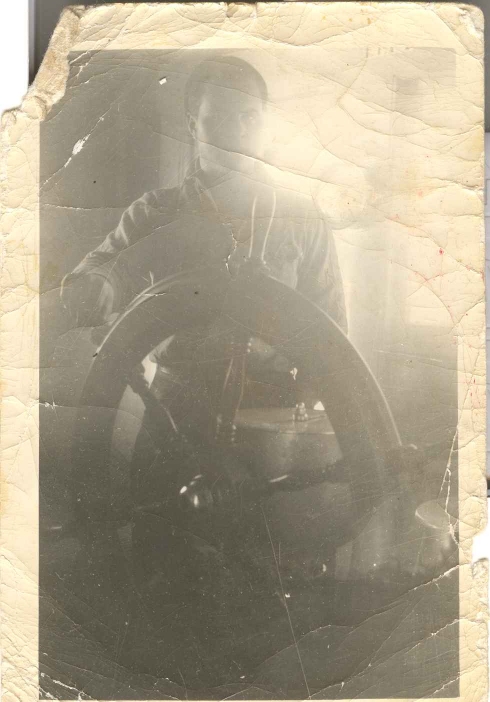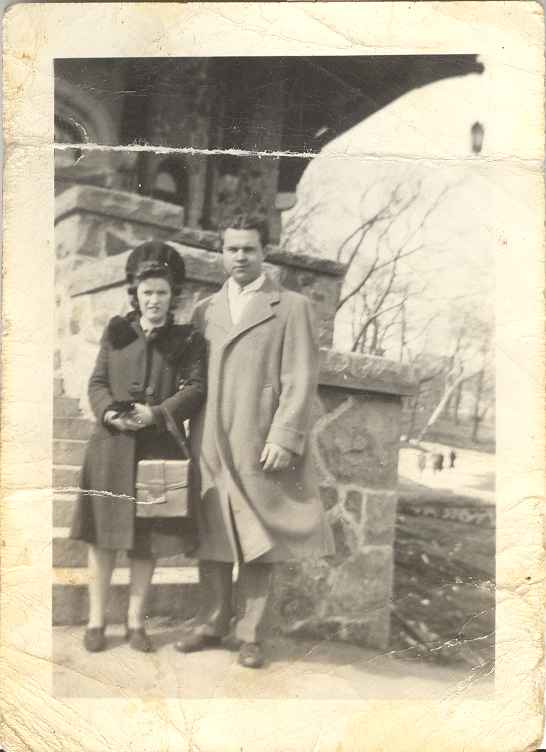Avro Anson, W1709, Collinstown Aerodrome
This incident was one of the smaller ones of the war and in itself created very little imprint on the war. but it was important to the men on board the aircraft as Canadian veteran Donald Mcleod recalled in emails sent in 2011. Donald was an Air Bomber trainee on April 5th, 1945 when his Anson trainer piloted by Sgt Arthur Banks was compelled to make a precautionary landing at Collinstown Aerodrome, Dublin.
The story is recorded in the Irish Army military Archives in Cahal Brugha barracks but I shall let Don McLeod tell his side of the story first.
 Recently there has been a lot of
Air crashes especially in the north. They always make me think
of my old flying days in the Air Force so one night playing
with the computer, I looked up Air Crashes in Ireland 39-45.
Recently there has been a lot of
Air crashes especially in the north. They always make me think
of my old flying days in the Air Force so one night playing
with the computer, I looked up Air Crashes in Ireland 39-45.
On one flight (May/45) we had motor trouble well out over the Irish Sea and had to make a forced landing near Dublin. I wondered if they had any record of it as I had no proof to show that it happened except a small insert in my Log Book. I was very surprised to find a long list, 48 pages of A/C forced landings and wrecks in Ireland, and much more surprised to see my name and crew on page 44. They had my full name & Air Force number R192444 also the aircraft Avro-Anson # 42. They listed 5 crew members but I think there was only four - the Staff pilot Arthur Banks, a student Navigator, a Wireless Operator and myself the Bomb Aimer.
We had been stationed at an Advanced Flying Unit at Bishops Court near Belfast for a month to get some practice bombing and flying before joining a permanent Crew.
April 5/45 -- the flight today would be about 3 hours,flying south to near Dublin then turning East across the Irish Sea to locate a target near Blackpool. Another left turn to take us back across the Irish Sea to drop 3 bombs on a water target off the Isle of Man then back to Base.
We were out about an hour when I noticed oil coming out of the overflow vent on port motor. I was afraid of it going on fire so went to the back side of the plane to see if it was getting near the hot exhausts. I went back to my seat with the pilot Banks, and told him about it. He said he knew something was wrong as the motor temp. was very high and the oil pressure was down. The Radio Operator could not reach Base so had the Navigator locate the nearest Airport at Colinstown. We decided to go there rather than risk a fire and ditch in the water. As we approached the Airport I loaded the Very Pistol and gave it to Banks to fire a red warning flare. They shot a green okay flare back -- Banks said afterward that he didnít see it as he was having trouble getting down on the runway with one motor. He bounced it fairly high before it settled down then taxied over to the office. We were surprised to see a group of Army Guards come out, so Banks went out to talk to them about fixing the motor. I went out to put the safety pins back in my three bombs in case somebody dropped them. We stayed in the aircraft about 10 minutes until they decided that they could repair it.
They interviewed each of us and were very friendly but I think we all worried about being detained or interned. We had a good chat, then they asked us all to come over to the Mess Hall for a nice bacon & egg dinner. Banks stayed with the Anson until they found out the problem with the motor was caused by fuel getting into the oil and diluting it. They changed the oil and had it done in a couple of hours. We were treated royally and enjoyed the afternoon, so glad not to be down in the water somewhere. They asked us to stay overnight & they would take us down town in Dublin but we all thought it would be better to get back to our base, so it was dark by the time we got away - each with a big box of nice Irish chocolates.
It took an hour to fly home so landed safely and were interviewed by the CO and officers. They advised us not to say anything about the incident as we could have been interned for the rest of the War. My old pal Bill Ullyott was also waiting to see why we didnít get back as they all knew we were missing. If we had kept going, it would have meant a motor fire or crash landing on the water. I notice that I had flown the previous week with a F/Sgt Langley as pilot of Anson 63 so Iím sure that he wasnít on this trip.
We finished our course there by the end of May then moved.
In May/45 we started our operational training at # 22 OTU at Wellesbourne, Mountford flying Wellingtons. Crewed up with Ken Tingey as Pilot, Doug Bell as Navigator, a Wireless operator and a wild tail gunner for a permanent crew of five now on the Wellingtons. Made one night trip over southern France north of Paris and bombed targets on the way back. We finished our two month course there, the war was over so we volunteered for the far East and were sent to 76 Base at Dalton in Yorkshire. In August we went to the heavy conversion unit HCU at Dishforth to begin final training on Lancasters. This was the end of our wars and flying in Sept. so were sent to the Repatriation Depot at Torquay, Devon to sail for home.
It was nice to get home in time to help finish off the harvest on the farm.
Don was also able to provide a copy of his flight log book page to show his being present on that aircraft in 1945:

The Irish Army file on this incident is a short one. They detail how an aircraft, identified as British, was sighted by the Coastwatching Service Look Out Post (LOP) on Howth Head at 13:45 hours, 5 miles east, moving west. The aircraft next landed at Collinstown Airport at 13:55 hours. The aircraft was undamaged the crew reported they were suffering a burst oil pipe. They also told the Irish authorities that they were on a training mission from Bishopscourt, Northern Ireland, to Blackpool and were to have returned there. Personell at the airport consisted of men of the 2nd Infantry Battalion under the 5th brigade of the Irish Army. The headquarters of the battalion reported officially the next day to 5th brigade, H.Q.:
'At 14.03 hrs on the 5/4/45 a British Anson medium Bomber landed at this Airport. The machine was a training machine and unarmed, with the exception of one dummy bomb carried in the 'plane. The crew consisted of five Sergeants whose names and numbers are submitted hereunder.
The 'plane had departed from Bishop's Court, Co. Down and it was one a training mission. It had been flying for approx. one hour.
Crew.
1458368 Flight Sergt. Banks, R.A.F.
1825006 " Bancutt, R.A.F.
R/192444 " McLeod R/Canadian A.F.
1570484 " Landgley, R.A.F.
R/253936 " Fitzner, R/Canadian A.F.
The orderly officer, Lieut. Hayes informed Air Defence, Command Intelligence, Brigade Headquarters and Battalion H.Q. Captain Comiskey from Aer Lingus informed O.C., Baldonnel.
The members of the crew were provided with a meal and cigarettes at the Post and refreshments were given to them in the Airport.
Captain Ryan from Baldonnel had supervised the repairs to the 'plane which were completed by 17.30 hours, Commandant Harrington gave permission for the Aircraft to take off and it departed at 17.40 hours."
The crew of the aircraft were difficult to track down. All were
of Non Commissioned Officer (NCO) rank and only their numbers
and surnames were recorded. It was possible to confirm with the
Canadian National Archives the full names of Sgts. McLeod and
Fitzner. Finally, the United Kingdom National Archives released
the name indexes of RAF airmen which then confirmed Arthur Banks
and Derek Langley's names. Flt Sgt "Bancutt" remained a mystery
until 2018 when he was finally identified as Frederick Ewen
BAWCUTT. It seems that his name was hand written down by
one Irish officer and transcribed there after as Bancutt.
Derek Langley it would appear was posted in July 1945 to 78
Squadron from 26 OTU. 78 Squadron at the time
transitioning from Halifax bombers to Dakota transports.
Strangley, Donald McLeod explained, he could not think who this fifth man was and why he would have been on the aircraft:
I still don't recall who Bancutt could have been .We had no need of a fifth man at that time as there are only four seats in the Anson. The Navigator & WAG sat in the centre section with the Bomb Aimer using the Co-pilots seat. We only kept a rough chart and pin-pointed all turning points and time data so didn't require a desk. Being up front we could always see where we were and watch out for other aircraft.
Donald recalls that Arthur Banks, the pilot on this flight, came from West Hartlepool in England. This he remembered because his own mother came from there.
The nephew of Frederick Fitzner provided these two photos of his uncle, who had been a merchant sailor prior to his enlistment.
 An undated image of Frederick aboard a ship. |
 Frederick Fitzner with his wife Buddy Fitzner, date unknown |
Shipping records show Frederick as a wheelman on the vessel
Lake Louise arriving in New York in January 1943.
A summary of his non overseas service is as follows: Enlisted in Montreal, 17 June 1943 and posted to No.5 Manning Depot. To No.18 Pre-Aircrew Education Detachment, 21 July 1943. To No.4 Wireless School, 1 October 1943. To Mountain View, 21 April 1944. Promoted Sergeant, 2 June 1944. To No.9 Air Observer School, 11 June 1944. To "Y" Depot, 22 September 1944. Taken on strength of No.3 PRC, Bournemouth, 11 October 1944. Repatriated to Canada, 29 January 1946. Released 14 March 1946.
He is found on the manifest of the Queen Elizabeth, sailing
home in February 1946 via New York. His address is listed
as Springside, Sask, and his trade that of Wireless Operator,
Air Gunner.
The aircraft they were flying on was an Avro Anson I, a type
which was familiar to Irish skies as the Irish Air Corps
operated a small number of similar aircraft and five had been
involved in previous incidents in Ireland including Anson LT985 and LV139
in Colinstown (Dublin) Airport, LT284 at Baldonnel, Anson DJ639
off Wexford and NK241 in Roscommon. The
aircraft concerned in this page event, Air Ministry serial
number W1709, was a veteran of the war at that stage. It
was first posted to 48 Squadron and then passed on through 6
(Coastal) Operational Training Unit, the SDU, the Air Ministry
Serviceing and Developement Unit, and finally 7 Air
Observers School. It was then according to The Anson File
by Air Britain, Struck off charge in November 1945.
Donald McLeod kindly also described his wartime career which seen him enter the service in late 1942, arrive overseas in Autumn of 1944 and after all the training they simply ran out of war:
After finishing the harvest on the farm, I went to Regina on Nov.1/42 to enlist in the Air Force. I met my school mate Don Woods there who was taking Pilot training at the Yorkton Base so that cinched my idea of being a Pilot. I enlisted the next morning for aircrew training. They offered me two weeks to go home which I refused so was sent on to Brandon Manning Depot in Manitoba on Nov 2/42.
After two months of Physical training & checkups I was sent on Mar.6 to an Initial Training School at Regina. Because I had a background of working on survey and using instruments, they advised me to be an Aircrew Navigator . I insisted on Pilot training as I had dreams of someday flying for Trans-Canada Airlines. So on May 15th about 20 of us marched out to the Regina Airport which became No.15 Elementary Training school flying Tiger Moth Biplanes. There were over 40 in the class altogether with each instructor having 5 of them. I liked flying , take-offs and landings were OK, cross country to Assiniboia and a Solo to Caronport were easy. Here I was proud to be selected to see that the 6 Tigers on the trip were filled with gas and collect the receipts for them. I felt comfortable flying them and ended up being the only student left with my instructor PO Patterson. I got lots of time and enjoyed the aerobatics, loops, rolls and spins. After nearly 2 months of that, I was sent to #12 Service Flying School at Brandon, Manitoba, flying twin engine Cessna Cranes. They were easy planes to land and nice in the air but was told that no more pilots would be sent overseas. All Staff pilots would have first choice so we would replace those guys at Nav., B&G, Wireless and other schools. I did not want that so they asked me to transfer to Navigation because of my background with instruments. Instead I agreed to train as a BombAimer as a quick way to go overseas and on a bombing crew. On Oct 10/43 I was sent to #3 Wireless School, Winnipeg to take a radio & wireless course then to start my trade at # 5 Bombing & Gunnery School at Dafoe, Sask--
Finally graduating at #5 Air Observer School on May21/44 as a Navigator -BombAimer --should have done this a year sooner. We were given a months leave then a Commando Course at Lachine, Quebec. Finally were sent to Halifax, Nova Scotia to board Ship Aquitania for our trip overseas . My pal for the past year, Bill Ullyott from Simpson, Sask was also a pilot turned B/A and we would be stationed together for another year. He was waiting at the hangers when we got back from Eire that night (5-4-45).
We arrived overseas on Sept 2/44 and were kept at #3 PRC at Bournemouth for 5 months doing nothing as there was now too many aircrew on hand . Had some flying on Tiger Moths at Fairoaks & Cambridge just to get used to the countryside. Got flying again at Bishops Court AFU in Ansons as the Bomb Aimer with different Pilots, Navigator & WAG every day .This was where the flight started on April 5 with F/S Banks and ended with forced landing at Collinstown
.Began training as a crew on Wellingtons with Pilot Ken Tringey and Navigator Doug Bell ,also a WAG & Tail gunner. We had another forced landing there on June 2/45, going down in a wicked thunderstorm in West Freugh ,Scotland . We just had to wait it out for two hours before going home, but we had contact with base. Finished our course there and moved to 76 Base at Dalton, Yorkshire to get on the big Lancasters .We had to get a new pilot as Tingey did not volunteer for the east, we also would pick up two more crew members but the war was all over and would soon be going home instead. Would have liked to try out Lancasters as that was my aim when first enlisting.
